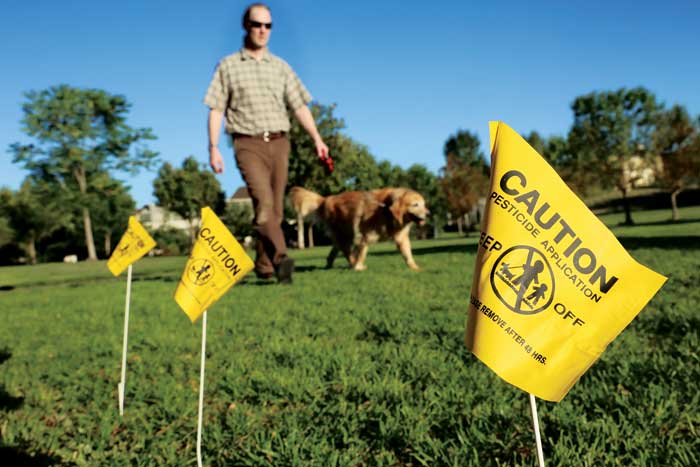I was cruising through the park the other day when my dog stopped to sniff some yellow flags. They weren’t yellowed from previous dog visits. Rather, they marked where pesticides had been applied. Holy guacamole! Need I worry about how much grass dear Fido had licked and trodden?
My inner toddler also wondered about kiddos in the neighborhood—how many had been attracted to those playful flags? Would crawling across the grass or brushing by recently sprayed bushes cause them immediate or long-lasting harm? To answer these questions I started my search at the epicenter of pesticide information: npic.orst.edu/ingred/aifact.html.
I learned that pesticides are used to control all sorts of creatures—weeds, bugs, rats and even fungi. Like sunscreens and medicines, they are multipart compounds. They include active ingredients for killing, confusing or repelling pests. They also include inactive ingredients that deliver or spread the active ingredients. Sometimes the part of a pesticide that harms us the most is not its active ingredient, but the solvents or “carriers” that facilitate its work. Like a cinema’s popcorn aroma, many pesticides also include attractants that entice pests to wander over and consume them.
Because many of our streetscapes, parks and yards are cultivated monocultures, they are like free all-you-can-eat buffets for many pests. Such greenery wouldn’t thrive without integrated pest management systems, which employ a suite of preventative pest measures. These include mechanical, cultural and biological controls, as well as occasional and judicious pesticide application.
In lawns, broadleaf herbicides like 2, 4-D (pronounced “two-four-dee”) are often sprayed to exterminate dandelions or dropped as pellets prior to emergence of weeds. In beds or sidewalk cracks where spiny beasts like Canada thistles rise up, indiscriminant herbicides like glyphosate (aka Roundup) kill them. Permethrin, a compound used on mosquito nets and for treating scabies, is also sprayed on trees and shrubs to kill beasts like ash borer beetles. The same ash trunks and surrounding soils are sometimes injected with acephate to provide a systemic offensive against leaf-sucking aphids and leaf-munching sawflies.
Unless your young’un or pup is gobbling pounds of dirt or scaling trees to eat handfuls of leaves, acephate and other injected pesticides are not a worry to you or your pets because they aren’t likely to contact the membranes they penetrate easily, like your skin. In contrast, permethrin isn’t absorbed well by human skin, and we quickly break it down and excrete it. But dog skin differs. Thus, when rubbing a raised leg against recently permethrin-coated tree trunks, our pooch might absorb enough to elicit strange behavior symptoms for a day or so.
But what about 2, 4-D and glyphosate? When these are applied as lawn-sprayed liquids, they are unlikely to be directly ingested by pets or kids because they are either absorbed by the leaves within a few hours or because they become stuck on soil particles. They don’t become mobile when rehydrated and aren’t easily absorbed through the skin. Meaning: don’t worry about rubbing against leaves or blades once they are dry, or even if they become rewetted after subsequent watering. The most likely casual exposure scenarios for these pesticides might occur if a child or pet feasts on loads of just-sprayed turf, or a pooch grooms after romping in it. Increased salivation, vomiting or diarrhea might occur, but bodies remove such toxins quickly (<1 day) without lasting permanent buildup or effects. As a parent, I’m more concerned about pellets used to suppress weeds before they emerge. If they linger, they could be eaten by pets or curious kiddos.
This brings us back to those funky yellow flags. Colorado requires professional applicators to flag any urban pesticide application, no matter what type or how small. So in public green spaces, recent flags are your cue for caution.
But because there is no law requiring flags to be removed, they may languish for weeks or even years, even if chemicals dry after only a few minutes. This can cause undue avoidance of an area. Sometimes such avoidance has benefits—by discouraging inconsiderate but pesticide-phobic dog walkers from leaving unwanted lawn deposits.
Some of you actively employ this fecal foil by seeding your lawn year-round with bright yellow flags. For your sake, I hope your neighborhood’s lazy poop-scoopers remain unaware. For the rest of you, I hope your pesticide worries have flagged.
James W. Hagadorn, PhD, is a scientist at the Denver Museum of Nature & Science.Suggestions and comments are welcome at jwhagadorn@dmns.org.





Thank you for this post! I know it is older but I just recently moved to Denver and the yellow flag thing was a big concern to me as I like to walk my dog often out and about the area. As I of course respect the lawn and pick up after my pup, I was worried about him running through those areas, him ingesting anything, tracking anything into our home, as well as human skin contact them from touching him. Maybe I’m too paranoid…but your post alleviated some worry 🙂
I checked the source you site and found these concerning notes that suggest the long term safety of 2,4D exposure is unknown but with potential for harm.
– The International Agency for Research on Cancer (IARC), had not assigned 2,4-D a cancer rating as of June 2008. However, in 1987, IARC placed the family of chlorophenoxy herbicides in Group 2B, possibly carcinogenic to humans.
-No experimental data are available regarding the effects of 2,4-D exposure on reproduction or development in humans.